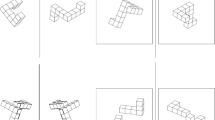Abstract
In the absence of visual feedback, the perceived position of the hands is systematically biased towards the plausible manual task space. Here we tested whether perceived orientation of the finger is similarly misperceived in right-handed individuals. Participants’ index fingers were passively rotated about the middle joint to a range of test angles, either in the frontoparallel plane (Experiment 1) or the horizontal plane (Experiment 2); they reported perceived orientation of the finger by rotating a visual line presented on a screen optically superimposed on the location of their unseen finger. Perceived finger orientations were biased towards positions that varied across hands and planes. Both hands were biased towards 10° inward in the frontoparallel plane and, in the horizontal plane, the left hand was biased towards 25° inward, whereas the right hand was biased towards 2° inwards. In a third experiment, participants reported finger orientation with respect to non-visual targets: gravitational vertical or straight ahead. Biases in perceived finger orientation to non-visual targets were similar to those found in the visual line task. The asymmetrical nature of biases across hands and planes reflects the typical orientation of the hands while working and supports the theory of a functional rather than anatomical representation of the fingers and hands in space.





Similar content being viewed by others
References
Bauermeister M, Werner H, Wapner S (1964) The effect of body tilt on tactual-kinesthetic perception of verticality. Am J Psychol 77:451–456
Chokron S, Colliot P, Atzeni T et al (2004) Active versus passive proprioceptive straight-ahead pointing in normal subjects. Brain Cognit 55:290–294. doi:10.1016/j.bandc.2004.02.015
Cohen MS (2008) Handedness questionnaire. http://www.brainmapping.org/shared/Edinburgh.php. Accessed 20 June 2002
Fraser LE, Makooie B, Harris LR (2015) The subjective visual vertical and the subjective haptic vertical access different gravity estimates. PLoS One 10:e0145528. doi:10.1371/journal.pone.0145528
Gau R, Noppeney U (2016) How prior expectations shape multisensory perception. Neuroimage 124:876–886
Ghilardi MF, Gordon J, Ghez C (1995) Learning a visuomotor transformation in a local area of work space produces directional biases in other areas. J Neurophysiol 73:2535–2539
Goble DJ, Brown SH (2007) Task-dependent asymmetries in the utilization of proprioceptive feedback for goal-directed movement. Exp Brain Res 180:693–704. doi:10.1007/s00221-007-0890-7
Goble DJ, Brown SH (2008a) Upper limb asymmetries in the matching of proprioceptive versus visual targets. J Neurophysiol 99:3063–3074. doi:10.1152/jn.90259.2008
Goble DJ, Brown SH (2008b) The biological and behavioral basis of upper limb asymmetries in sensorimotor performance. Neurosci Biobehav Rev 32:598–610. doi:10.1016/j.neubiorev.2007.10.006
Haggard P, Newman C, Blundell J, Andrew H (2000) The perceived position of the hand in space. Percept Psychophys 62:363–377. doi:10.3758/BF03205556
Jones SAH, Cressman EK, Henriques DYP (2010) Proprioceptive localization of the left and right hands. Exp Brain Res 204:373–383. doi:10.1007/s00221-009-2079-8
Kappers AML (1999) Large systematic deviations in the haptic perception of parallelity. Perception 28:1001–1012. doi:10.1068/p2802
Kappers AML, Viergever RF (2006) Hand orientation is insufficiently compensated for in haptic spatial perception. Exp Brain Res 173:407–414. doi:10.1007/s00221-006-0377-y
Longo MR, Haggard P (2012) A 2.5-D representation of the human hand. J Exp Psychol Hum Percept Perform 38:9–13
Mao HF, Hsueh IP, Tang PF et al (2002) Analysis and comparison of the psychometric properties of three balance measures for stroke patients. Stroke 33:1022–1027. doi:10.1161/01.STR.0000012516.63191.C5
Mittelstaedt H (1983) A new solution to the problem of the subjective vertical. Naturwissenschaften 70:272–281
Oldfield RC (1971) The assessment and analysis of handedness: the Edinburgh inventory. Neuropsychologia 9:97–113
Rohde M, van Dam LCJ, Ernst MO (2016) Statistically optimal multisensory cue integration: a practical tutorial. Multisensory Res 29:279–317
Schmidt L, Artinger F, Stumpf O, Kerkhoff G (2013a) Differential effects of galvanic vestibular stimulation on arm position sense in right- versus left-handers. Neuropsychologia 51:893–899. doi:10.1016/j.neuropsychologia.2013.02.013
Schmidt L, Keller I, Utz KS et al (2013b) Galvanic vestibular stimulation improves arm position sense in spatial neglect: a Sham-stimulation-controlled study. Neurorehabil Neural Repair 27:497–506. doi:10.1177/1545968312474117
Schöne H, Lechner-Steinleitner S (1978) The effect of preceding tilt on the perceived vertical: hysteresis in perception of the vertical. Acta Otolaryngol 85:68–73
Vindras P, Desmurget M, Prablanc C, Viviani P (1998) Pointing errors reflect biases in the perception of the initial hand position. J Neurophysiol 79:3290–3294
Volcic R, Kappers AML (2008) Allocentric and egocentric reference frames in the processing of three-dimensional haptic space. Exp Brain Res 188:199–213. doi:10.1007/s00221-008-1353-5
Watson AB, Pelli DG (1983) QUEST: a Bayesian adaptive psychometric method. Percept Psychophys 33:113–120. doi:10.3758/BF03202828
Acknowledgments
This research was supported by a Discovery grant from the Natural Sciences and Engineering Research Council (NSERC) of Canada. LF is supported by an Ontario Graduate Scholarship and an NSERC CREATE grant.
Author information
Authors and Affiliations
Corresponding author
Ethics declarations
Conflict of interest
The authors declare no conflict of interest in this work.
Rights and permissions
About this article
Cite this article
Fraser, L.E., Harris, L.R. Perceived finger orientation is biased towards functional task spaces. Exp Brain Res 234, 3565–3574 (2016). https://doi.org/10.1007/s00221-016-4752-z
Received:
Accepted:
Published:
Issue Date:
DOI: https://doi.org/10.1007/s00221-016-4752-z




